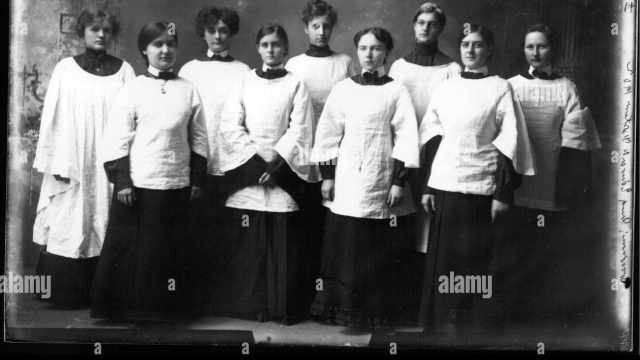
Harmonizing in Hues: The Meaning and Majesty of Choir Robes

The sound of heavenly voices fills the air, the harmonies blending together in perfect unison. As we watch the choir perform, our attention is drawn not only to their angelic voices but also to their majestic attire – the choir robes. These flowing garments, adorned with rich hues and intricate designs, hold a symbolic significance that goes beyond their visual appeal.
Stepping onto the stage, the choir members don their robes, which instantly transform them into a collective entity, transcending individuality and forming a unified chorus. The garments, carefully chosen with thoughtful consideration, represent the togetherness and unity of the choir. Like a magnificent tapestry woven with threads of different shades, the choir robes signify the blending of various personalities and vocal talents to create a magnificent musical tapestry.
Through the centuries, choir robes have held a special place in the realm of choral performances. They carry on a tradition that encapsulates the heritage and dignity of sacred and secular musical gatherings alike. Beyond the practical aspect of providing a sense of uniformity, the robes serve to evoke reverence and professionalism, setting the stage for the powerful musical experience that is to follow. With every flowing fold and vibrant hue, the choir robes create an atmosphere of grandeur, reminding us of the centuries-old artistry and devotion poured into the creation of music.
As we delve deeper into the meaning and majestic presence of choir robes, we uncover a rich history intertwined with music and spirituality. From their origins in the church choirs of medieval times to their modern-day presence in various choral ensembles, their journey is one entwined with grace and aesthetics. The choir robes provide not only a visual feast for the eyes but also serve as a visual representation of the profound emotions that music can evoke.
In the following sections, we will explore the different aspects of choir robes, their symbolic significance, and the role they play in enhancing the choral experience. Join us as we dive into the history, colors, and designs of choir robes, learning how they contribute to the magnificence and unity of choral performances.
Historical Significance of Choir Robes
Choir robes hold a rich and storied history, steeped in tradition and symbolism. These garments have been an integral part of choral performances for centuries, providing both visual appeal and a sense of unity among singers. Let us delve into the historical significance of choir robes and uncover the origins of this cherished tradition.
Choir robes trace their roots back to medieval times when choirs were primarily associated with religious institutions. During this era, the church played a central role in society, and music was an essential element of worship. The adoption of robes by choirs served as a way to distinguish them from the general congregation and to symbolize their elevated status within the religious community.
As choirs evolved and expanded beyond the boundaries of the church, choir robes continued to hold significance in various secular settings. In academic institutions, such as universities and colleges, choir robes became a symbol of academic achievement and were worn during significant ceremonies such as convocations and graduations. The tradition of donning robes distinguished singers as part of a respected academic community, reflecting the honor and pride associated with musical prowess.
Beyond their practical uses, choir robes also serve a vital cogitative purpose. The ability of robes to conceal individuality and foster a sense of collective identity has solidified their importance in choral performances. When singers don their robes, they become part of a unified whole, where personal distinctions fade into the background, allowing for a focus on the harmonious expressions of music. The robes serve as a reminder to singers that they are integral parts of a larger ensemble, promoting a sense of camaraderie and cooperation.
In conclusion, the historical significance of choir robes lies in their ability to encapsulate centuries of tradition and symbolism. From the humble beginnings in religious ceremonies to their adoption in academic and secular settings, choir robes have served as visual representations of a shared identity and purpose. By donning these robes, singers not only honor the past but also cultivate a sense of unity and collective spirit in their performances. The legacy of choir robes continues to endure, enriching our appreciation of choral music and the powerful emotions it evokes.
Symbolism of Colors in Choir Robes
Colors play a vital role in the symbolism of choir robes. They not only add visual appeal to the ensemble but also convey deeper meanings and messages. Each color has its own significance and adds to the overall aura of the performance.
White:
White is often associated with purity, innocence, and light. It symbolizes the spiritual nature of the choir’s music and their devotion to their faith. White choir robes can create an ethereal atmosphere, representing the divine and heavenly aspects of their singing.
Red:
Red is a powerful color that symbolizes passion, energy, and love. When incorporated into choir robes, it can evoke a sense of warmth and fervor in the performance. It signifies the strength of the choir’s emotions and their enthusiasm for expressing their faith through music.
Blue:
Blue is commonly associated with calmness, serenity, and spirituality. It represents tranquility and harmony, reflecting the choir’s desire to create a peaceful and harmonious atmosphere through their singing. Blue choir robes can bring a sense of introspection and depth to the musical experience.
Green:
Green is often linked to nature, growth, and renewal. Incorporating this color into choir robes symbolizes the choir’s continuous growth, both as individuals and as a collective unit. It signifies their commitment to spiritual development and their desire to inspire growth and renewal among their audience.
Purple:
Purple is a color traditionally associated with royalty, power, and grandeur. When used in choir robes, it conveys a sense of majesty and dignity. It symbolizes the choir’s elevated status as messengers of their faith, and their ability to impart a profound spiritual experience to those who listen to their music.
Yellow:
Yellow is a vibrant and joyful color associated with happiness, positivity, and enlightenment. Incorporating yellow into choir robes brings a sense of brightness and optimism to the performance. It symbolizes the choir’s intent to uplift spirits and spread positivity through their uplifting and inspiring music.
By carefully selecting the colors of their choir robes, choirs can enhance the visual impact of their performances and add layers of meaning to their music. The symbolism of colors creates a richer and more immersive experience for both the choir and their audience, making each performance a truly unforgettable event.
Practical Considerations and Contemporary Trends
Choir robes play an integral role in the overall performance and aesthetic appeal of any choral group. They not only contribute to the unity and professionalism of the choir but also serve practical purposes. Choir robes are designed with careful consideration to facilitate ease of movement and provide comfort for singers during rehearsals and performances.
The contemporary trends in choir robe design focus on combining functionality with modern fashion. One prominent trend is the use of lightweight and breathable fabrics that enable singers to perform without feeling constricted or uncomfortable. These fabrics not only enhance the overall experience for the choir members but also allow for better ventilation, particularly during longer performances.
Choir Robes For Adults
Another trend in choir robe design is the incorporation of customizable elements. Choir robes now come in a variety of colors and styles, allowing choral groups to select robes that align with their unique branding or artistic vision. From vibrant hues to subtle pastels, choristers have the opportunity to choose robes that complement both the repertoire they perform and the venue in which they perform.
Furthermore, contemporary choir robe designs often feature practical additions, such as pockets for storing small essentials like sheet music, tuning forks, or personal items. This enables singers to have everything they need readily accessible during rehearsals and performances, ensuring seamless transitions and uninterrupted focus on their music.
In conclusion, practical considerations and contemporary trends have led to the evolution of choir robe designs. These robes now not only enhance the visual impact of a choral performance but also prioritize the comfort and functionality of the singers. With lightweight fabrics, customizable options, and practical features, choir robes have become an essential component in creating harmonious and memorable musical experiences.



